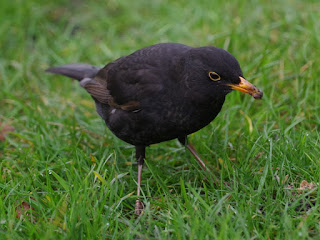Update: Conehead54 has identfied the plant. He says, 'They're feeding on the seeds of one of the Conyza fleabanes -- probably C. sumatrensis -- weedy aliens that are common in London's waste areas.'
A Great Tit looked for insects in a the bark of a Chinese water fir in the Dell. The park is full of exotic trees planted in the 19th century.
A Coal Tit looked warily out of the yew tree near the bridge, waiting till the coast was clear before it came to my hand to take a pine nut.
A Robin was also waiting.
A Blackbird found a small larva in the lawn of the Rose Garden.
A pair of Pied Wagtails hunted for insects on the edge of the lake near the Dell restaurant. The bird shown singly is the female, with a grey back rather than black. The restaurant is being renovated, and I turned down the deafening sound on this video.
The pigeon-killing Lesser Black-Backed Gull had eaten as much of his latest kill as he wanted, but when three Carrion Crows came down to peck at the carcass he jealously stood over it.
When a gull has a distinguishing feature,such as the unusually bright yellow legs of this Common Gull, you notice that it keeps to quite a small area on the shore -- not exactly a territory, more a sphere of influence in which it is as high as possible in the local pecking order.
A group of Black-Headed Gulls posed neatly on the fallen poplar tree in the Long Water.
A Cormorant caught a fish at the other end of the Long Water, and swallowed it neatly before spitting out the leaves that had come up with it.
The pale female Great Crested Grebe of the pair that hang around the island can usually be seen resting in exactly the same place ...
... while her distinctively dark mate wanders around.
He strayed into the territory of the next pair and was chased off.
A Moorhen checked a plastic bag to see if it contained food.
The Bar-Headed--Greylag Goose hybrid is very aware of plastic bags carried by people, and comes over to see if you will feed it. It ate some sunflower seeds from my hand.
On a nasty day the Little Owl at the Queen's Temple stays low down in her hole. If you stand on the pavement of the temple, so that you are fairly high up, and look into the hole from a distance, you can just see the top of her spotted head. (This is the worst photograph of a Little Owl that I have ever published, but it makes a point.)













It may not be the best picture ever published, but it does its job of giving us an inkling about the Little Owl's secret life very well.
ReplyDeleteOh for someone to make pairs of fuzzy slippers in the likeness of a sleeping Grebe. I would positively throw money in the direction of whomever made it happen.
I don't think I've ever seen Long Tailed Tits stay in one place for so long. A real luxury.
This was absolutely the first time I've seen Long-Tailed Tits doing this. I don't know what the plant is.
DeleteHi Ralph- lovely video of the Long-tailed Tits. They're feeding on the seeds of one of the Conyza fleabanes- probably C. sumatrensis- weedy aliens that are common in London's waste areas.
ReplyDeleteLoved the photo of the Lesser Black-back with Crows hoping for a tit bit + the Cormorant with a mix of leaves + a fish. Nice to speak to you on tom's phone last weekend.
Thanks very much for the identification. I had no idea what it was, and have been walking past this patch for months without taking any notice of it until it was suddenly alive with small birds.
Delete